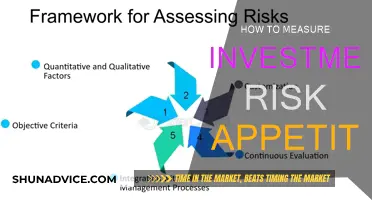
Creating an investment portfolio with $500 is a great way to get started with investing. An investment portfolio is a collection of assets, such as stocks, bonds, mutual funds, and exchange-traded funds (ETFs), that can help individuals generate income or grow their wealth. When building an investment portfolio, it is important to consider one's financial goals, risk tolerance, and time horizon.
1. Determine your financial goals: Are you saving for retirement, a down payment on a house, or some other financial goal? Knowing your goals will help guide your investment strategy.
2. Assess your risk tolerance: How comfortable are you with taking on risk? Higher-risk investments can lead to higher rewards but also come with a greater possibility of losses.
3. Choose an investment account: Consider using a tax-advantaged retirement account like an IRA or a regular taxable brokerage account, depending on your goals.
4. Select your investments: With a limited budget, you may want to focus on low-cost investments such as ETFs or index funds, which offer instant diversification and lower fees.
5. Monitor and rebalance: Regularly review your investment portfolio to ensure it aligns with your goals and risk tolerance. Make adjustments as necessary to maintain a balanced portfolio.
Remember, investing involves risk, and there is no one-size-fits-all approach. It is always recommended to do your own research or consult a financial advisor before making any investment decisions.
| Characteristics | Values |
|---|---|
| First Step | Determining your asset allocation |
| Second Step | Picking individual assets for your portfolio |
| Third Step | Monitoring the diversification of your portfolio |
| Fourth Step | Reassessing and rebalancing |
| Investment Portfolio Definition | A collection of invested assets such as stocks, bonds, funds, real estate, and cash |
| Risk Tolerance | Your ability to accept investment losses in exchange for the possibility of higher investment returns |
| Time Horizon | How long you'll need to hold the investments until you require the money |
| Short-Term Goals | Goals where you'll need the money within 12 months |
| Medium-Term Goals | Goals that take between one and five years to accomplish |
| Long-Term Goals | Goals that take more than five years to reach |
| Conservative Investors | Focus on protecting the value of their portfolio, with a larger portion of bonds and less in equities |
| Aggressive Investors | More risk-tolerant, with a larger portion of their portfolio in equities |
What You'll Learn

Understanding your risk tolerance
Time Horizon
The time horizon for your financial goals plays a significant role in determining your risk tolerance. If you have long-term financial goals, such as saving for retirement or a child's education, you may have a longer time horizon. In this case, you might be willing to take on more risk by investing in stocks or other higher-risk assets, as you have more time to recover from potential short-term losses. On the other hand, if your financial goals are short-term, such as saving for a down payment on a house or a planned expense within the next year, you may have a shorter time horizon and opt for more conservative, lower-risk investments like cash, certificates of deposit, or money market accounts.
Investment Goals
The nature of your investment goals will also influence your risk tolerance. If you are investing for retirement or to achieve financial stability, you may be more conservative in your approach and seek investments with guaranteed returns. Conversely, if you are investing with disposable income or risk capital, you may be more aggressive and willing to take on higher-risk investments for the potential of greater returns. Understanding your investment goals and priorities is essential for determining your comfort level with risk.
Age and Net Worth
Your age and net worth are additional factors that contribute to your risk tolerance. Generally, younger investors are perceived to have a longer time horizon and are often considered more risk-tolerant, making them more inclined to invest in stocks and stock funds. However, it's important to base your risk tolerance on your individual circumstances rather than solely on age. Your net worth and liquid capital also impact your risk tolerance. Individuals with higher net worth and more financial resources can typically afford to take on more risk, as they have a larger buffer to withstand potential losses.
Investment Experience
Your level of investment experience can also shape your risk tolerance. If you are new to investing, it's generally advisable to proceed with caution and gain experience before taking on substantial risk. Understanding the dynamics of the market and different investment vehicles can help you make more informed decisions about the level of risk you are comfortable with.
Risk Tolerance Assessments
To help determine your risk tolerance, you can utilise various risk tolerance assessments available online. These often take the form of surveys or questionnaires that evaluate your financial situation, goals, and comfort with risk. While these assessments can provide a starting point, it's important to remember that they may be biased towards the products or services offered by the sponsoring companies or individuals.
Monthly Savings: Where to Invest for Maximum Returns
You may want to see also

Choosing an investment account
Investment Goals
Before choosing an investment account, it is crucial to identify your investment goals. Are you investing for retirement, a down payment on a house, or some other financial goal? Different investment accounts offer different benefits and are better suited for certain goals. For example, tax-advantaged accounts like IRAs and 401(k)s are typically used for long-term retirement goals, while taxable brokerage accounts are often used for shorter-term goals like saving for a house.
Time Horizon
Consider how long you plan to invest for. Are you investing for the short term (less than a year), medium term (1-5 years), or long term (more than 5 years)? Your time horizon will impact the types of investments you choose and the level of risk you are comfortable with. For example, if you are investing for the short term, you may prefer lower-risk investments to avoid potential losses, while for long-term goals, you can afford to take on more risk.
Risk Tolerance
Assess your risk tolerance, or how much risk you are comfortable with in your investment portfolio. Are you willing to accept the potential for larger losses in exchange for the possibility of higher returns? Generally, the more risk you can take, the more aggressive your portfolio will be, with a larger portion allocated to stocks or equities. On the other hand, if you are risk-averse, you may prefer a more conservative portfolio with a higher allocation to bonds and other fixed-income securities.
Tax Implications
Consider the tax implications of different investment accounts. Some accounts, like traditional IRAs and 401(k)s, offer tax advantages by allowing you to contribute pre-tax dollars and defer taxes until withdrawal. On the other hand, Roth IRAs and Roth 401(k)s are funded with after-tax dollars, allowing for tax-free withdrawals in retirement. Regular taxable brokerage accounts offer more flexibility in accessing your money but do not provide the same tax benefits.
Account Types
There are several types of investment accounts to choose from. Retirement accounts like IRAs and 401(k)s are specifically designed for retirement savings and often include tax advantages. Brokerage accounts, on the other hand, offer more flexibility in terms of investment choices and accessing your money but may not have the same tax benefits as retirement accounts.
Fees and Minimums
When choosing an investment account, be sure to consider any associated fees and minimum investment requirements. Different accounts may have varying fees, such as management fees or transaction fees, which can impact your overall returns. Additionally, some accounts may have minimum deposit requirements, so be sure to review these before selecting an account.
Professional Advice
If you are unsure about which investment account to choose, consider seeking professional advice. Financial advisors or robo-advisors can help you assess your financial goals, risk tolerance, and investment options to make informed decisions. They can provide guidance on account types, investment strategies, and portfolio management.
Remember, choosing an investment account is an important step in building your investment portfolio. Take the time to consider your goals, time horizon, risk tolerance, and the features of different account types to make an informed decision that aligns with your investment strategy.
Investment-Led Growth: Impact on National Savings and Economy
You may want to see also

Selecting investments
Now that you have a better understanding of your goals, risk tolerance, and time horizon, it's time to select the specific investments that will make up your portfolio. Here are some options to consider:
- Stocks: Stocks, also known as equities, represent ownership in a company. They tend to be higher-risk but offer higher potential returns. You can purchase individual stocks or invest in funds that hold a diverse collection of stocks.
- Bonds: Bonds are a type of loan to companies, governments, or other entities. They are considered less risky than stocks and provide a fixed rate of return, making them a good option for more conservative investors.
- Mutual Funds: Mutual funds allow you to invest in a diverse basket of securities, such as stocks or bonds, that are professionally selected by fund managers. While they provide instant diversification, they also come with management fees.
- Exchange-Traded Funds (ETFs): ETFs are similar to mutual funds but are traded on an exchange like stocks. They are passively managed, tracking a specific index or basket of stocks, and typically have lower fees than mutual funds.
- Real Estate: You can invest in real estate directly or through real estate investment trusts (REITs). This option provides exposure to the real estate market and can offer steady income and potential for capital appreciation.
- Alternative Investments: Precious metals, cryptocurrencies, hedge funds, and commodities are examples of alternative investments that can further diversify your portfolio. However, these investments tend to be riskier than traditional stocks and bonds.
- Cash and Cash Alternatives: Savings accounts, certificates of deposit (CDs), and money market funds offer low-risk options for your portfolio, although they may provide modest returns.
When selecting investments, it's important to consider your risk tolerance and time horizon. If you have a higher risk tolerance and a long time horizon, you may allocate a larger portion of your portfolio to stocks and other higher-risk investments. On the other hand, if you have a lower risk tolerance or a shorter time horizon, you may want to focus more on bonds, cash, and other more conservative investments.
Additionally, consider diversifying your portfolio by investing in different asset classes and industries. This helps to spread out your risk and smooth out returns over time. You can use tools like Morningstar Categories to better understand the different types of investments and how they can fit into your portfolio.
Remember, investing comes with risks, and the value of your investments may fluctuate. It's always a good idea to do your own research and consult with a financial professional before making any investment decisions.
Equity Linked Savings Schemes: A Smart Investment Guide
You may want to see also

Determining asset allocation
Determining your asset allocation is the first step in constructing a portfolio. It is important to consider your individual financial situation and goals, such as your age, the time you have to grow your investments, the amount of capital to invest, and future income needs. For example, a 22-year-old college graduate just beginning their career will have different investment goals and risk tolerance than a 55-year-old married person expecting to help pay for a child's college education and retire in the next decade.
Another factor to consider is your personality and risk tolerance. Are you willing to risk losing some money for the possibility of greater returns? While everyone wants high returns, if short-term losses keep you up at night, those returns may not be worth the stress. Clarifying your current situation, future capital needs, and risk tolerance will help determine how your investments should be allocated among different asset classes.
Generally, the more risk you can bear, the more aggressive your portfolio will be, with a larger portion devoted to equities and less to bonds and other fixed-income securities. On the other hand, the less risk you can assume, the more conservative your portfolio will be. For example, a conservative portfolio might focus on protecting its value, with an allocation of current income from bonds and some long-term capital growth potential from high-quality equities.
Your risk tolerance is also tied to how much time you have before your financial goals, such as retirement. If your goal is many years away, you have more time to ride out the highs and lows of the market, which will allow you to take advantage of the market's general upward progression. Younger people saving for retirement can primarily invest in stocks to maximise the growth of their portfolio's value because they have time to recover from any large losses. Later in life, as they approach retirement and their risk tolerance decreases, they can concentrate their portfolios more heavily in bonds.
Creating a Schedule for Investment Savings
You may want to see also

Monitoring and rebalancing
When monitoring your investments, it is crucial to use appropriate benchmarks to understand their performance accurately. For instance, compare a large-cap fund's performance to a relevant benchmark, such as the S&P 500, instead of a small-cap fund benchmark.
If your yearly check-up reveals that your portfolio is out of balance, it may be time to rebalance. Rebalancing involves buying or selling asset classes to restore your portfolio to its original target allocation. This may mean taking profits from asset classes that have experienced strong growth and investing in asset classes that have not grown as quickly. To maintain your portfolio's balance, consider pruning any asset class that has overgrown its target by 5%.
There are various methods for rebalancing your portfolio:
- Calendar-based rebalancing: This method involves resetting the portfolio to the target asset allocation at a designated frequency, such as quarterly or yearly.
- Threshold-based rebalancing: This approach is triggered when the portfolio's asset allocation deviates beyond a certain threshold. However, it requires regular monitoring, which may be impractical for those managing their portfolios.
- Combination of calendar- and threshold-based rebalancing: This strategy combines both methods, where the portfolio is rebalanced based on a calendar frequency if its assets stray by a specific percentage from the target allocation.
While there is no optimal frequency for rebalancing, annual rebalancing is often considered a good practice. However, the most important thing is to choose a schedule that you can easily follow and stick to it.
Savings Strategies: Where to Invest for Maximum Returns
You may want to see also
Frequently asked questions
An investment portfolio is a collection of assets and can include stocks, bonds, mutual funds, exchange-traded funds (ETFs), and more.
First, determine your financial goals and risk tolerance. Then, decide on the level of help you want, whether you'll use a robo-advisor or financial advisor, or take a DIY approach. Next, choose an investment account, such as an IRA or taxable brokerage account, and select your investments based on your goals and risk tolerance.
Common types of investments include stocks, bonds, mutual funds, and ETFs. Stocks are a tiny slice of ownership in a company, while bonds are loans to companies or governments that get paid back with interest and are considered safer but typically have lower returns. Mutual funds and ETFs provide instant diversification, allowing you to invest in a basket of securities.
Asset allocation refers to how you split your portfolio among different types of assets, and it depends on your risk tolerance. A common rule of thumb is to subtract your age from 100 or 110 to determine the portion of your portfolio allocated to stocks. For example, if you're 30, this suggests allocating 70%-80% to stocks and 20%-30% to bonds.
Periodically revisit your asset allocation and rebalance your portfolio as needed. Monitor your portfolio's performance and adjust your investment strategy as life changes. For example, getting married, having children, receiving an inheritance, or retiring may require rethinking your investment approach.
Remember, investing carries risks, and past performance does not guarantee future results. It's essential to do your research and carefully consider your financial situation, goals, and risk tolerance before investing.







